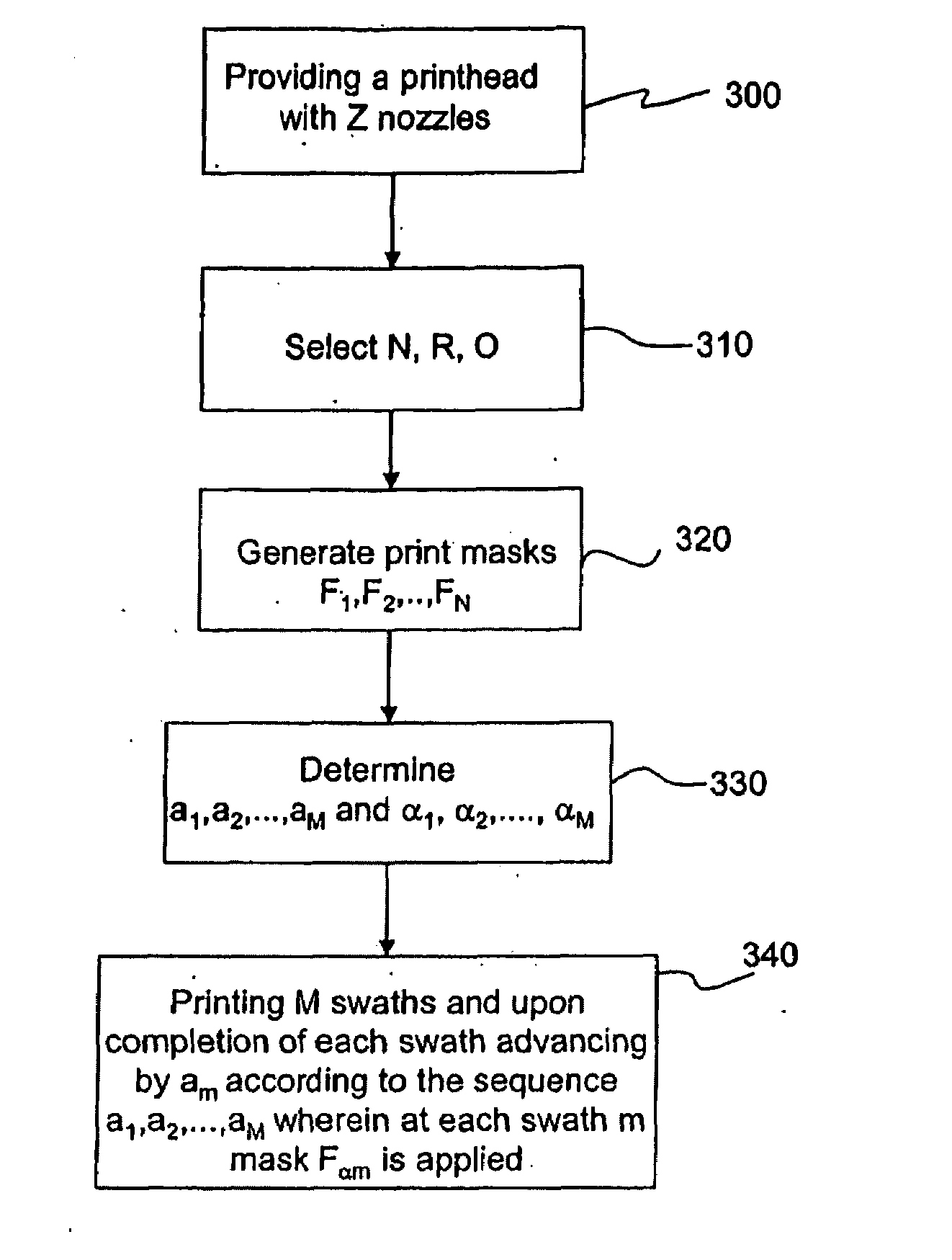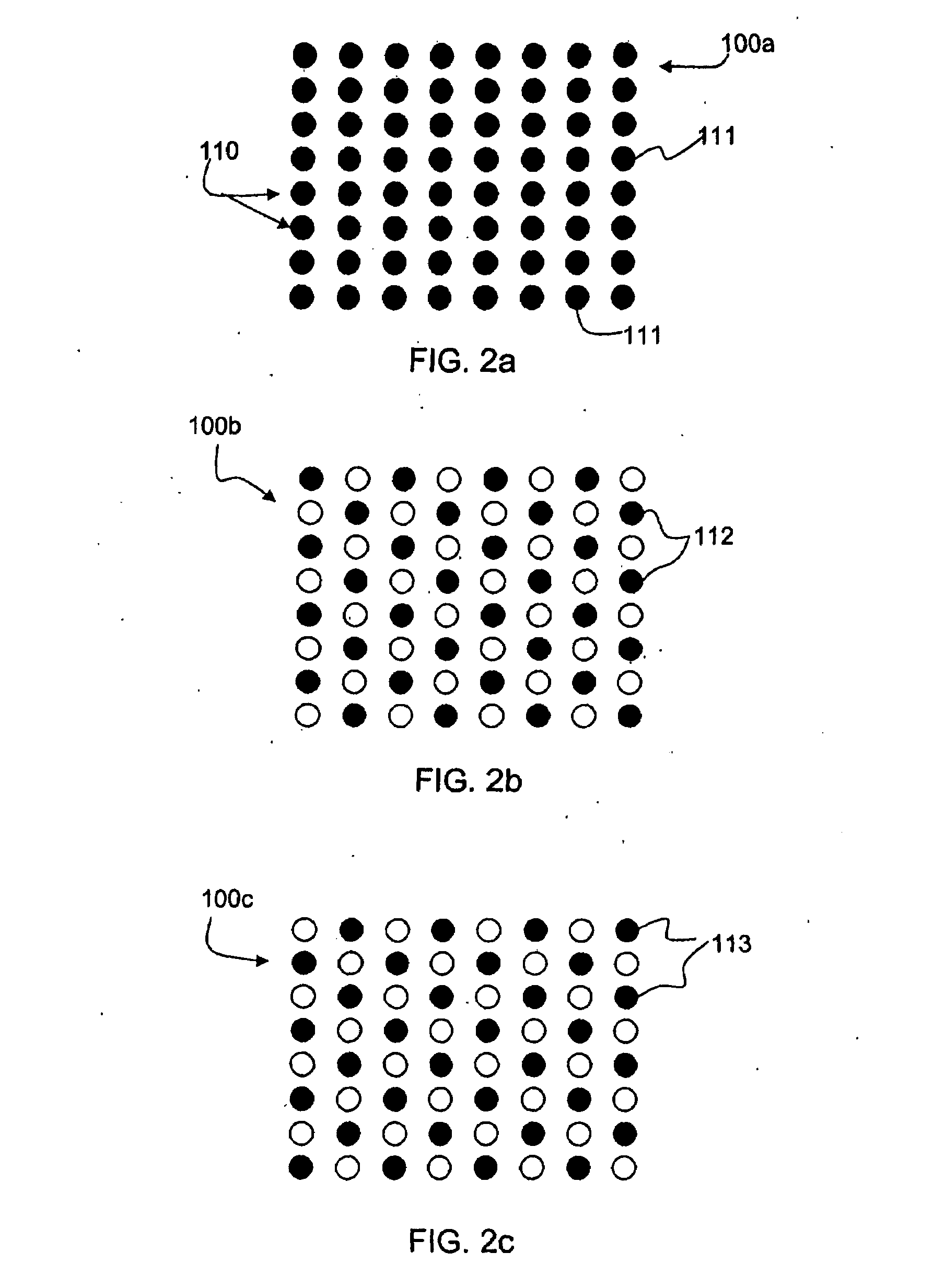Method and system for high speed multi-pass inkjet printing
a multi-pass inkjet printing and high-speed technology, applied in the field of high-speed multi-pass inkjet printing, can solve the problems of insufficient multi-pass printing mode to improve print quality to an acceptable level, significant dot placement errors in the advancement direction of the nozzle located at the top and bottom of the printhead, and print quality defects, etc., to achieve the effect of fast print carriage speed and high speed
- Summary
- Abstract
- Description
- Claims
- Application Information
AI Technical Summary
Benefits of technology
Problems solved by technology
Method used
Image
Examples
example 1
[0061]A vertically interlaced multi-pass printing mode having N=3 and R=2 and using a printhead comprising at least a column of 129 writing nozzles (Z=129) is considered. An even print medium advance is considered, where m=1, 2, . . . , 6. The following three complementary print masks, {F1, F2, F3}, each of 129 rows, are defined:
F1=[100100100100100…100100100100100…100100100100100…………………………………………………………………………………100100100100100…100100100100100…100100100100100…](8)F2=[000………00010010010010010…10010010010010…10010010010010…………………………………………………………………………………………………………………………10010010010010…10010010010010…10010010010010…]F3=[000000………………0000001001001001001…1001001001001…1001001001001…………………………………………………………………1001001001001…1001001001001…1001001001001…]
[0062]With reference to Eq. (4), ω=(1,2,3,4,5,6). The vector representing the set of advances necessary to print the image bitmap is a={43,43,43,43,43,43}. By applying Eq. (7), the vector representing the mask indices, αm, is α={1,1,2,2,3,3}.
example 2
[0063]An interlaced multi-pass printing mode as that described in Example 1 is considered, with the difference that herein an uneven print medium advance sequence is selected. Three complementary print masks as those given in (8) are defined. A standard method of random shuffling selects vector ω to be ω={2,3,5,4,1,6}. From Eq. (4) and Eq. (7), the sequence of print medium advances and the sequence of mask indices is determined to be: a={44,43,44,41,39,37} and α={1,2,3,2,1,3}
[0064]One problem that comprises accurate dot placement is swath height errors of the inkjet printhead. Swath height errors are commonly produced by mechanical defects in the substrate of the printhead and can produce erroneous dot placement artifacts, such as ink drops are ejected at an angle to a printing medium rather than perpendicularly thereto. Since the majority of defective nozzles tend to be present mostly at the ends of the printhead, a way of reducing the effect of swath height errors, i.e., to minimi...
example 3
[0080]An Interlaced multi-pass printing mode having N=3 and R=2 and using a printhead comprising at least a column of 129 writing nozzles (Z=129) is considered. The number O of the nozzles of the end regions is 9. An even print medium advance is considered, where m=1, 2, . . . , 6. Three complementary print masks, {F1, F2, F3}, each of 129 rows, are defined and reported in FIG. 8. The 9 first rows and the last 9 rows of Fi (i=1, 2, 3) corresponding to the nozzles of the end regions of the printhead contribute only to a shingling mode N+1, while the remaining 111 rows contribute to both shingling modes N and N+1.
[0081]With reference to Eq. (4), ω={1,2,3,4,5,6}. By applying Eq. (9) the vector representing the set of advances necessary to print the image bitmap is a={40,40,40,40,40,40}. By applying Eq. (7), the vector representing the mask indices, αm, is α={1,1,2,2,3,3}.
[0082]FIG. 9 is a flow chart of a method of printing ink drops configured to form an image bitmap on a print medium ...
PUM
 Login to View More
Login to View More Abstract
Description
Claims
Application Information
 Login to View More
Login to View More - R&D
- Intellectual Property
- Life Sciences
- Materials
- Tech Scout
- Unparalleled Data Quality
- Higher Quality Content
- 60% Fewer Hallucinations
Browse by: Latest US Patents, China's latest patents, Technical Efficacy Thesaurus, Application Domain, Technology Topic, Popular Technical Reports.
© 2025 PatSnap. All rights reserved.Legal|Privacy policy|Modern Slavery Act Transparency Statement|Sitemap|About US| Contact US: help@patsnap.com



